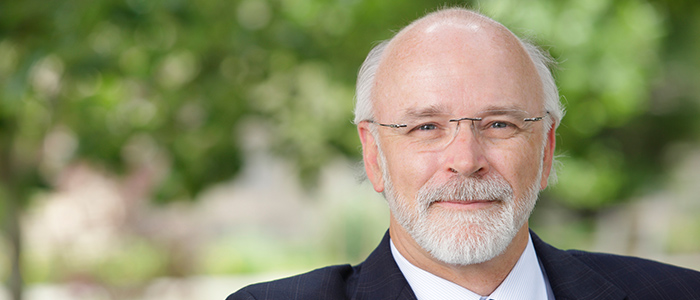Gearing up for his second term

For Dr. Michael J. Strong, Dean of the Schulich School of Medicine & Dentistry, the past four and half years have been nothing short of invigorating. Now, as he is about to head into his second term, he’s putting the wheels in motion to continue building on the great work already accomplished in order to achieve the School’s vision of becoming a global leader in optimizing life-long health.
During his first term as Dean Strong initiated change on almost every front: research, education, financial and budget management, and internationalization. He’s quick to acknowledge how strongly positioned the School was when he took over the reins as Dean, which he believes provided the foundation for the tremendous growth and change.
Unquestionably there have been a few lessons along the way. Most unexpected for Dr. Strong have been the incredible demands of the job. “I thought I had good time-management skills before, but this is a completely different world,” he said. “I need to be prepared in advance for anyone I am scheduled to meet with, and to deal with a wide range of issues that cross my desk on any given day – some of which are planned, some not.”
It was in 2011, during his first year as Dean, when a 10-year strategic plan, chock-full of goals, was launched. For Dr. Strong there’s a great sense of satisfaction in reviewing that plan, as several major projects have been initiated with many more completed. Amongst the achievements, a few stand out.
The completion of a new building to house the Department of Family Medicine, the Centre for Studies in Family Medicine, and the new Master of Public Health (MPH) Program was one of the earliest achievements. With that building came the charter class for MPH — a one-of-a-kind public health program in Canada that incorporates a unique curriculum based on case-based teaching modules.
With nearly 30 new faculty members recruited in the past 30 months, the School’s research and education programs have also been enriched.
Dr. Strong credits, in part, the establishment of a new budgeting process for the success of the recruitment. “Creating a new process in which we have centralized certain aspects of the budget, where we ensure that basic departments have no deficit, and for which we have tremendous engagement from all our Chairs, has made a difference,” said Dr. Strong. “In the absence of this, we wouldn’t have been able to achieve what we have.”
Another highlight of the past few years for Dr. Strong, has been the establishment of the Southwestern Ontario Academic Health Network (SWAHN).
A partnership that includes academic institutions, hospitals and community partners, SWAHN has a goal to strengthen academic networking to improve health through the implementation of unique projects. “In my professional career, there have been several attempts at establishing an academic health network,” said Dr. Strong. “This is a huge task. Through the tireless dedication of Dr. Margaret Steele and her colleagues, we have achieved it.”
Despite the success related to this activity, it’s the way in which the School has come together and functioned as a single entity that Dr. Strong has found most satisfying. “We’ve done really difficult things,” said Strong. “And the amount of participation and the amount of input we have received and how we have functioned as one School is very rewarding.”
Dr. Strong is the first to admit that the pace of change at the School has been rapid. He believes this will subside during the next few years.
At the same time, work will move forward on a few major projects. “I need our Distributed Education Network to be firing on all cylinders, our MPH program to continue to grow and spread its wings, to advance our international mandate, and would like to see the London Medical Innovation Consortium becmoe a reality,” said Dr. Strong.
On the national front, Dr. Strong continues to work with his fellow deans on some fundamental issues such as the research-funding model, the social responsibility of medical schools and how the student body reflects the demographic of the Canadian population, and the challenges faced by the more than 4,000 Canadians studying medicine abroad who return home in hopes of finding a residency position.
Regardless, Dr. Strong is enthusiastic about his second term. And he’s grateful to his wife Wendy, his daughter and two sons who feed his optimistic spirit and give him the energy to keep up with the daunting pace of his workdays.
Dr. Strong believes the School is uniquely positioned to achieve its goals and overcome some of the challenges before it.
“Being situated in Southwestern Ontario, the School is truly representative of the mosaic of Canada,” said Dr. Strong. “This gives our students a tremendous advantage from a clinical practice, experiential learning and research perspective. Not only do we offer the best student experience at a research-intensive university, we are ‘right-sized’ and we have created a community where people feel a sense of belonging, faculty are approachable and the opportunities are endless.”
Dr. Strong’s second term will continue until 2021.








